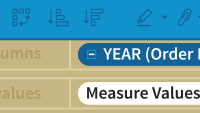Description
In this course, you will learn:-
- Connecting to a variety of data sources and cleaning up the information.
- combining several datasets (Union, Blending, cross-database Joins, and many more).
- Data visualization takes the form of charts, graphs, maps, plots, and so on.
- Tips and tricks for using statistics to tell a clear and effective tale.
- Tableau Database or Fast Engine is a concept (Extracts).
- Developing or changing your career path in the areas of data science and analytics
- Drilldown, sorting, grouping, and the development of sets and clusters are all examples of visual analytics. Parameters, Tooltips, Annotations, and Reference Lines are all examples of data filtering.
- Create a dashboard out of your report.
- Tableau: Using Maps and Playing with Geographical Data Types.
- Calculations such as aggregate calculations, Date, Logical, String, Number, and other sorts of calculations can be written in a very complicated and sophisticated manner.
Syllabus:-
-
Tableau Tutorial: Lecture 0 - Introduction To Tableau
-
Tableau Tutorial: Lecture 1 - Getting Started with Tableau
-
Tableau Tutorial: Lecture 2 - Exploring Basic Tableau
-
Tableau Tutorial: Lecture 3 - Deep Dive Into Tableau Visualization
-
Tableau Tutorial: Lecture 4 - Distribution Charts And Blending Data
-
Tableau Tutorial: Lecture 5 Massaging The Input Data
-
Tableau Tutorial: Lecture 6 Advanced Visualization Techniques
-
Tableau Tutorial: Lecture 7 Advanced Filtering Techniques
-
Tableau Tutorial: Lecture 8 Tableau Visualization Using Maps
-
Tableau Tutorial: Lecture 9 Advanced Tableau Visualization Using Pareto Charts
-
Tableau Tutorial: Lecture 10 Advanced Tableau Visualization Using Waterfall Char
-
Tableau Tutorial: Lecture 11 Tableau Calculations and LOD (Level of details)








